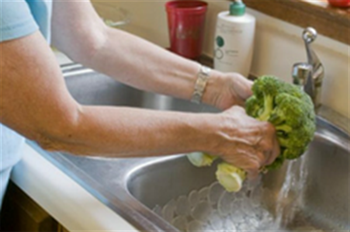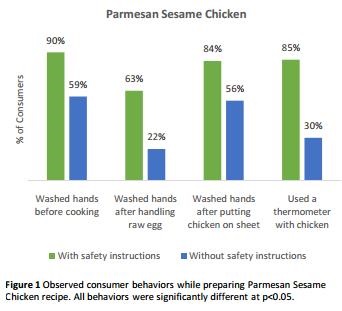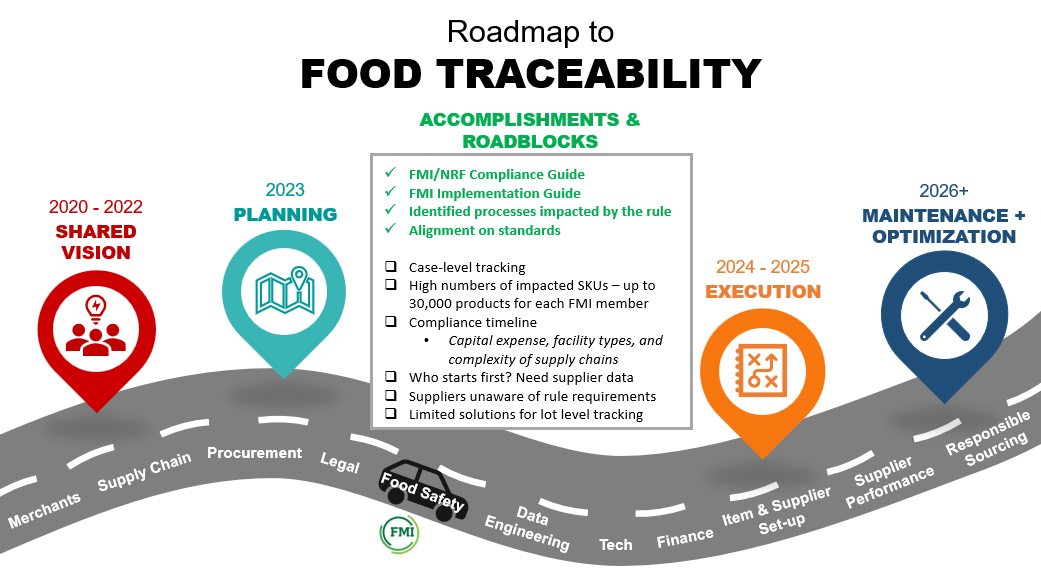By: Ashley Eisenbeiser, MS, CFS, Director, Food and Product Safety Programs, Food Marketing Institute
 When it comes to recipes, countless albums on my Pinterest profile are dedicated to finding a quick family meal that everyone will love. According to the 2014 report on Retail Contributions to Health and Wellness 2014, 100 percent of the food retailers surveyed reported offering healthy recipes to shoppers, with 80 percent offering the recipes online and 59% offering them also in store. Traditionally, recipes provide step-by-step instructions on how-to prepare meals, but what if recipes were modified to improve food safety practices during meal preparation?
When it comes to recipes, countless albums on my Pinterest profile are dedicated to finding a quick family meal that everyone will love. According to the 2014 report on Retail Contributions to Health and Wellness 2014, 100 percent of the food retailers surveyed reported offering healthy recipes to shoppers, with 80 percent offering the recipes online and 59% offering them also in store. Traditionally, recipes provide step-by-step instructions on how-to prepare meals, but what if recipes were modified to improve food safety practices during meal preparation?
In a recent Partnership for Food Safety Education webinar, Sandria Godwin, Professor, College of Agriculture, Human and Natural Sciences, Tennessee State University, shared her recent research which evaluated whether modifying recipes to include food safety instructions would result in improved food safety practices when cooking poultry. Previous studies show that recipes are a common source of food preparation information and 25 percent of poultry recipes recommend an end-point cooking temperature; additionally, recipes that include food safety information can change reported food safety behaviors.
Godwin’s research found consumers who used recipes that included food safety instructions, specifically including these instructions within the preparation steps of the recipe, improved their food safety behaviors. These improved food safety behaviors include a significant increase in the number of consumers who washed their hands before cooking and after handling raw ingredients as well as the number of consumers using a food thermometer. Furthermore, the majority of consumers stated they liked the idea of recipes with the included food safety instructions and would like to use these recipes in the future.

As recipe-sharing continues to grow and retailers continue to promote more family meals at home, consumers will be looking for more information on how-to prepare foods safely in their homes. This will provide retailers and supermarket registered dieticians the opportunity to not only become a resource for mealtime solutions but also a food safety resource to help customers safely prepare meals at home.
For more food safety education materials to use in store, visit www.FightBAC.org.
Source for chart: Maughan, Chambers IV, Godwin, 2016

 Industry Topics address your specific area of expertise with resources, reports, events and more.
Industry Topics address your specific area of expertise with resources, reports, events and more.
 Our Research covers consumer behavior and retail operation benchmarks so you can make informed business decisions.
Our Research covers consumer behavior and retail operation benchmarks so you can make informed business decisions.
 Events and Education including online and in-person help you advance your food retail career.
Events and Education including online and in-person help you advance your food retail career.
 Food Safety training, resources and guidance that help you create a company food safety culture.
Food Safety training, resources and guidance that help you create a company food safety culture.
 Government Affairs work — federal and state — on the latest food industry policy, regulatory and legislative issues.
Government Affairs work — federal and state — on the latest food industry policy, regulatory and legislative issues.
 Get Involved. From industry awards to newsletters and committees, these resources help you take advantage of your membership.
Get Involved. From industry awards to newsletters and committees, these resources help you take advantage of your membership.
 Best practices, guidance documents, infographics, signage and more for the food industry on the COVID-19 pandemic.
Best practices, guidance documents, infographics, signage and more for the food industry on the COVID-19 pandemic.
